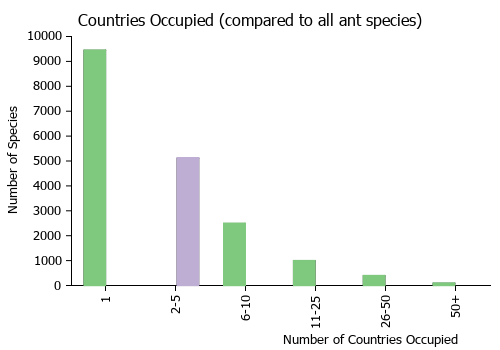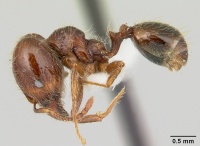Pheidole gertrudae
| Pheidole gertrudae | |
|---|---|

| |
| Scientific classification | |
| Kingdom: | Animalia |
| Phylum: | Arthropoda |
| Class: | Insecta |
| Order: | Hymenoptera |
| Family: | Formicidae |
| Subfamily: | Myrmicinae |
| Tribe: | Attini |
| Genus: | Pheidole |
| Species group: | gertrudae |
| Species: | P. gertrudae |
| Binomial name | |
| Pheidole gertrudae Forel, 1886 | |
| Synonyms | |
| |
Nothing is known about the biology of gertrudae.
Identification
See the description in the nomenclature section.
Keys including this Species
Distribution
Widespread in Brazil, from Amazonas to Santa Catarina; also recorded from Tipuani, La Paz, Amazonian Bolivia (var. leonhardi types); Canindeyli Department, Paraguay; and Loreto, Misiones, northern Argentina (var. loretensis types). (Wilson 2003)
Latitudinal Distribution Pattern
Latitudinal Range: 25.68015° to -27.331°.
| North Temperate |
North Subtropical |
Tropical | South Subtropical |
South Temperate |
- Source: AntMaps
Distribution based on Regional Taxon Lists
Neotropical Region: Argentina, Bolivia, Brazil (type locality), Colombia, Paraguay.
Distribution based on AntMaps
Distribution based on AntWeb specimens
Check data from AntWeb
Countries Occupied
| Number of countries occupied by this species based on AntWiki Regional Taxon Lists. In general, fewer countries occupied indicates a narrower range, while more countries indicates a more widespread species. |

|
Estimated Abundance
| Relative abundance based on number of AntMaps records per species (this species within the purple bar). Fewer records (to the left) indicates a less abundant/encountered species while more records (to the right) indicates more abundant/encountered species. |

|
Biology
Castes
Worker
Minor
Images from AntWeb
   
| |
| Worker. Specimen code casent0178029. Photographer April Nobile, uploaded by California Academy of Sciences. | Owned by ALWC, Alex L. Wild Collection. |
Nomenclature
The following information is derived from Barry Bolton's Online Catalogue of the Ants of the World.
- gertrudae. Pheidole gertrudae Forel, 1886b: xlii (w.) BRAZIL. Mayr, 1887: 592 (s.). Senior synonym of humilis: Kempf, 1960f: 463; of leonhardi, loretensis: Wilson, 2003: 537.
- leonhardi. Pheidole gertrudae var. leonhardi Forel, 1901h: 62 (s.w.) BOLIVIA. Junior synonym of gertrudae: Wilson, 2003: 537.
- humilis. Megalomyrmex (Wheelerimyrmex) humilis Borgmeier, 1930: 35, pl. 5, figs. 34, 36 (w.) BRAZIL. Junior synonym of gertrudae: Kempf, 1960f: 463.
- loretensis. Pheidole (Pheidole) gertrudae var. loretensis Santschi, 1933e: 108 (w.) ARGENTINA. Junior synonym of gertrudae: Wilson, 2003: 537.
Unless otherwise noted the text for the remainder of this section is reported from the publication that includes the original description.
Description
From Wilson (2003): DIAGNOSIS With the distinctive qualities of the gertrudae group: propodeal spines greatly reduced to absent in major, absent in minor; propodeal spiracle extremely large; entire body mostly smooth and shiny. Differs from other members of group (Pheidole capillata, Pheidole jeannei, q.v.) in the major in the following combination of traits: no rugoreticulum on head, humerus subangulate in dorsal-oblique view; no trace of a propodeal spine, with the basal and declivitous faces of the propodeum in side view meeting in a very wide oblique angle.
MEASUREMENTS (mm) Lectotype major: HW 1.30, HL 1.34, SL 0.76, EL 0.26, PW 0.62. Para lectotype type minor: HW 0.64, HL 0.66, SL 0.72, EL 0.14, PW 0.40.
COLOR Major: concolorous light reddish yellow.
Minor: concolorous light brownish yellow.
Figure. Upper: lectotype, major. Lower: paralectotype, minor. Scale bars = 1 mm.
Type Material
BRAZIL: Guanabara, Rio de Janeiro. Musee d'Histoire Naturelle Genève - as reported in Wilson (2003)
Etymology
Named in honor of Gertrude Naegeli. (Wilson 2003)
References
- Albrecht, M., Gotelli, N.J. 2001. Spatial and temporal niche partitioning in grassland ants. Oecologia 126, 134–141 (doi:10.1007/s004420000494).
- Albuquerque, E., Prado, L., Andrade-Silva, J., Siqueira, E., Sampaio, K., Alves, D., Brandão, C., Andrade, P., Feitosa, R., Koch, E., Delabie, J., Fernandes, I., Baccaro, F., Souza, J., Almeida, R., Silva, R. 2021. Ants of the State of Pará, Brazil: a historical and comprehensive dataset of a key biodiversity hotspot in the Amazon Basin. Zootaxa 5001, 1–83 (doi:10.11646/zootaxa.5001.1.1).
- Casadei-Ferreira, A., Economo, E.P., Feitosa, R.M. 2020. Additions to the taxonomy of Pheidole (Hymenoptera: Formicidae) from the southern grasslands of Brazil. Revista Brasileira de Entomologia 64(4):e20200068 (doi:10.1590/1806-9665-RBENT-2020-0068).
- Forel, A. 1886b. Espèces nouvelles de fourmis américaines. Ann. Soc. Entomol. Belg. 30:xxxviii-xlix. (page xlii, worker described)
- Garcia, F.R.M., Ovruski, S.M., Suárez, L., Cancino, J., Liburd, O.E. 2020. Biological control of tephritid fruit flies in the Americas and Hawaii: A review of the use of parasitoids and predators. Insects 11, 662. (doi:10.3390/insects11100662).
- Glaser, S.M., Feitosa, R.M., Koch, A., Goß, N., do Nascimento, F.S., Grüter, C. 2021. Tandem communication improves ant foraging success in a highly competitive tropical habitat. Insectes Sociaux. (doi:10.1007/s00040-021-00810-y).
- Guerrero, R.J., Fernandez, F., Escarraga, M.E., Perez-Pedraza, L.F., Serna, F., Mackay, M.P., Sandoval, V., Vergara, V., Suarez, D., Garcia, E.I., Sanchez, A., Meneses, A.D., Tocora, M.C., Sosa-Calvo, J. 2018. New records of myrmicine ants (Hymenoptera: Formicidae) for Colombia. Revista Colombiana de Entomología 44: 238-259 (DOI 10.25100/socolen.v44i2.7115).
- Kempf, W. W. 1960f. Miscellaneous studies on Neotropical ants (Hymenoptera, Formicidae). Stud. Entomol. (n.s.) 3: 417-466 (page 463, senior synonym of humilis)
- Ladino, N., Feitosa, R.M. 2022. Ants (Hymenoptera: Formicidae) of the Parque Estadual São Camilo, an isolated Atlantic Forest remnant in western Paraná, Brazil. ZOOLOGIA 39: e22001 (doi:10.1590/S1984-4689.v39.e22001).
- Mayr, G. 1887. Südamerikanische Formiciden. Verh. K-K. Zool.-Bot. Ges. Wien 37: 511-632 (page 592, soldier described)
- Przybyszewski, K.R., Silva, R.J., Vicente, R.E., Garcia Freitas, J.V., Pereira, M.J.B., Izzo, T.J., Tonon, D.S. 2020. Can baited pitfall traps for sampling dung beetles replace conventional traps for sampling ants? Sociobiology 67, 376-387 (doi:10.13102/sociobiology.v67i3.5201).
- Wilson, E. O. 2003. Pheidole in the New World: A dominant, hyperdiverse ant genus. Cambridge, Mass.: Harvard University Press, [ix] + 794 pp.: 794pp (page 537, fig. major, minor described, Senior synonym of leonhardi, loretensis)
References based on Global Ant Biodiversity Informatics
- Brandao C. R. F., R. Silvestre, and A. Reis-Menezes> Influencia das interacoes comportamentais entre especies de formigas em levantamentos faunisticos em communidades de Cerrado> pp 371-404> In martins R. P., T. M. Lewinsohn, and M. S. Barbeitos (eds). Ecologia e comportamento de insetos. Serie Oecologia Brasiliensis, vol. VIII. PPGE-URFJ, Rio de Janeiro, Brasil.
- Costa-Milanez C. B., G. Lourenco-Silva, P. T. A. Castro, J. D. Majer, and S. P. Ribeiro. 2014. Are ant assemblages of Brazilian veredas characterised by location or habitat type? Braz. J. Biol. 74(1): 89-99.
- Cuezzo, F. 1998. Formicidae. Chapter 42 in Morrone J.J., and S. Coscaron (dirs) Biodiversidad de artropodos argentinos: una perspectiva biotaxonomica Ediciones Sur, La Plata. Pages 452-462.
- Dias N. D. S., R. Zanetti, M. S. Santos, M. F. Gomes, V. Peñaflor, S. M. F. Broglio, and J. H. C. Delabie. 2012. The impact of coffee and pasture agriculture on predatory and omnivorous leaf-litter ants. Journal of Insect Science 13:29. Available online: http://www.insectscience.org/13.29
- Dias N. S., R. Zanetti, M. S. Santos, J. Louzada, and J. H. C. Delabie. 2008. Interaction between forest fragments and adjacent coffee and pasture agroecosystems: responses of the ant communities (Hymenoptera, Formicidae). Iheringia, Sér. Zool., Porto Alegre, 98(1): 136-142.
- Escalante Gutiérrez J. A. 1993. Especies de hormigas conocidas del Perú (Hymenoptera: Formicidae). Revista Peruana de Entomología 34:1-13.
- Fernández, F. and S. Sendoya. 2004. Lista de las hormigas neotropicales. Biota Colombiana Volume 5, Number 1.
- Forel A. 1901. Formiciden des Naturhistorischen Museums zu Hamburg. Neue Calyptomyrmex-, Dacryon-, Podomyrma- und Echinopla-Arten. Mitt. Naturhist. Mus. Hambg. 18: 43-82.
- Forel A. 1908. Ameisen aus Sao Paulo (Brasilien), Paraguay etc. gesammelt von Prof. Herm. v. Ihering, Dr. Lutz, Dr. Fiebrig, etc. Verhandlungen der Kaiserlich-Königlichen Zoologisch-Botanischen Gesellschaft in Wien 58: 340-418.
- Forel A. 1912. Formicides néotropiques. Part III. 3me sous-famille Myrmicinae (suite). Genres Cremastogaster et Pheidole. Mémoires de la Société Entomologique de Belgique. 19: 211-237.
- Kempf, W.W. 1972. Catalago abreviado das formigas da regiao Neotropical (Hym. Formicidae) Studia Entomologica 15(1-4).
- Kusnezov N. 1952. El género Pheidole en la Argentina (Hymenoptera, Formicidae). Acta Zoologica Lilloana 12: 5-88.
- Kusnezov N. 1978. Hormigas argentinas: clave para su identificación. Miscelánea. Instituto Miguel Lillo 61:1-147 + 28 pl.
- Luederwaldt H. 1918. Notas myrmecologicas. Rev. Mus. Paul. 10: 29-64.
- Montine P. S. M., N. F. Viana, W. Dattilo, A. S. Santanna, L. Martins, and A. B. Vargas. 2014. Seasonality of Epigaeic Ant Communities in a Brazilian Atlantic Rainforest. Sociobiology 61(2): 178-183.
- Ribeiro L. F., R. R. C. Solar, T. G. Sobrinho, D. C. Muscardi, J. H. Schoereder, and A. N. Andersen. 2019. Different trophic groups of arboreal ants show differential responses to resource supplementation in a neotropical savanna. Oecologia 190(2): 433-443.
- Rosa da Silva R. 1999. Formigas (Hymenoptera: Formicidae) do oeste de Santa Catarina: historico das coletas e lista atualizada das especies do Estado de Santa Catarina. Biotemas 12(2): 75-100.
- Santos M. S., J. N. C. Louzada, N. Dias, R. Zanetti, J. H. C. Delabie, and I. C. Nascimento. 2006. Litter ants richness (Hymenoptera, Formicidae) in remnants of a semi-deciduous forest in the Atlantic rain forest, Alto do Rio Grande region, Minas Gerais, Brazil. Iheringia, Sér. Zool., Porto Alegre, 96(1): 95-101.
- Santos P. P., A. Vasconcelos, B. Jahyny, and J. H. C. Delabie. 2010. Ant fauna (Hymenoptera, Formicidae) associated to arboreal nests of Nasutitermes spp. (Isoptera, Termitidae) in a cacao plantation in southeastern Bahia, Brazil. Revista Brasileira de Entomologia 54(3): 450-454.
- Santschi F. 1933. Fourmis de la République Argentine en particulier du territoire de Misiones. Anales de la Sociedad Cientifica Argentina. 116: 105-124.
- Silvestre R., C. R. F. Brandão, and R. R. Silva da 2003. Grupos funcionales de hormigas: el caso de los gremios del cerrado. Pp. 113-148 in: Fernández, F. (ed.) 2003. Introducción a las hormigas de la región Neotropical. Bogotá: Instituto de Investigación de Recursos Biológicos Alexander von Humboldt, xxvi + 424 pp.
- Silvestre R., M. F. Demetrio, and J. H. C. Delabie. 2012. Community Structure of Leaf-Litter Ants in a Neotropical Dry Forest: A Biogeographic Approach to Explain Betadiversity. Psyche doi:10.1155/2012/306925
- Suguituru S. S., M. Santina de Castro Morini, R. M. Feitosa, and R. Rosa da Silva. 2015. Formigas do Alto Tiete. Canal 6 Editora 458 pages
- Vittar, F. 2008. Hormigas (Hymenoptera: Formicidae) de la Mesopotamia Argentina. INSUGEO Miscelania 17(2):447-466
- Wild, A. L. "A catalogue of the ants of Paraguay (Hymenoptera: Formicidae)." Zootaxa 1622 (2007): 1-55.
- da Silva, R.R., C.R.F. Brandao, and R. Silvestre. 2004. Similarity Between Cerrado Localities in Central and Southeastern Brazil Based on the Dry Season Bait Visitors Ant Fauna. Studies on Neotropical Fauna and Environment 39(3):191-199.
- de Almeida Soares S., Y. R. Suarez, W. D. Fernandes, P. M. Soares Tenorio, J. H. C. Delabie, and W. F. Antonialli-Junior. 2013. Temporal variation in the composition of ant assemblages (Hymenoptera, Formicidae) on trees in the Pantanal floodplain, Mato Grosso do Sul, Brazil. Rev. Bras. entomol. 57: 84-90


